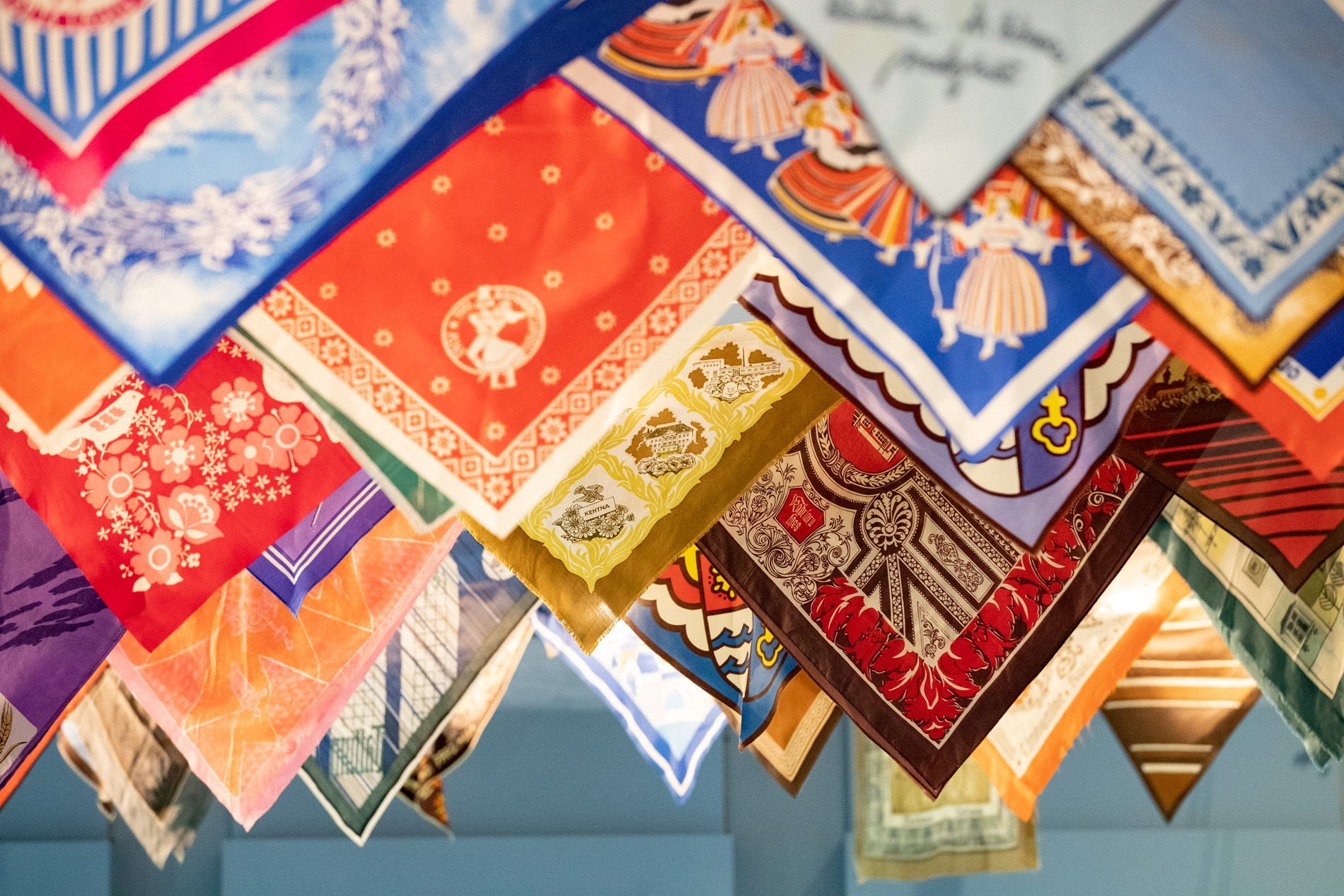
New exhibition! Messages in a Triangle
Friday, 14. apr 2023
*
Souvenir scarfs from Estonia’s song festivals, the Olympic Games, cities, events and institutions were valued accessories in the 20th century and reflected everyday life in Estonia during the Soviet period. They were designed by recognised artists expressing the art trends and fashions of the times. These scarfs were often also canvases for ideals of freedom, bringing messages from the free world into the grey reality of Soviet life. The exhibition "Messages in a Triangle: An Exhibition of Estonian 20th-Century Souvenir Scarfs" is open at ENM from 14th of April until 29th of October 2023.
Souvenir scarfs were popular for many decades, and were widely designed and produced in Estonia in particular – more so than in any other occupied Soviet republic. They constituted a peculiarly Estonian phenomenon.
The long-standing tradition of handmade scarfs played an important part in this. Such scarfs tended to be made spontaneously using whatever was to hand, often to mark a special gathering or group event such as a summer retreat or camp.
‘Messages in a Triangle’ forms part of the discourse on people’s ability to cope and the preservation of national ideals during the Soviet era which the Estonian National Museum showcases in its exhibitions. Throughout history, scarfs have been worn as a symbol of unity and uniformity, which meant that they paired perfectly with Soviet ideology. However, there was a surprising amount of creative freedom in the design of souvenir scarfs in particular, with no real limit on self-expression. For this reason, the exhibition also examines how everyday items were used to instil, between the lines, a sense of security, of remaining yourself in an occupied state. The 20th-century tradition of souvenir scarfs certainly had an impact on everyday life in Estonia during the Soviet era and around the time the country regained its independence. Many stories are connected to them, and associations with them continue to evoke powerful feelings in those who remember them.
In preparing the exhibition we undertook an extensive project we called ‘From Closet to Exhibition’ to collect as many scarfs and stories as we could. More than 300 scarfs were donated to the museum, and we also received 60 wonderful stories giving a personal angle on these everyday items.
With both the exhibition and the magazine accompanying it we also want to shine the spotlight on the designers of the scarfs, about whom very little was previously known: they went uncredited on the finished items, and museums have seldom collected scarfs based on the artists’ names. And yet all of these designers were professional textile artists who graduated from what was then the Estonian National Institute of Arts. We interviewed quite a number of designers, among them Peeter Kuutma, Lylian Meister, Ilona Gurjanova, Kaire Tali, Mariann Kallas, Heli Karu, Linda Roos-Himma and Sigrid Huik. We also spoke to Kai Saar, the senior artist with the Soviet-era Tallinn Fashion House, about the era and its scarf designs, and to journalist Kalev Vapper about his clear recollections of the souvenirs produced for the Tallinn-based sailing events at the 1980 Olympics. You will find their interviews in the exhibition.
In preparing the exhibition we worked with the Estonian Academy of Arts, the national broadcaster ERR, Tartu City Museums, the Estonian Museum of Applied Art and Design, the Estonian History Museum, Tallinn City Museum, the Estonian Sports and Olympics Museum, Võru County Museum, Pärnu Museum and Saaremaa Museum.
Curators: Kertu Saks, Kadi Haamer & Reet Piiri
Producer: Piret Simson
Designer: Liina Unt
Graphic designer: Kadri Hallik
Texts: Kertu Saks & Reet Piiri
Interviews: Kertu Saks
Photographs: Herkki-Erich Merila, Anu Ansu, Arp Karm & Berta Jänes
Our thanks to all experts, designers, partners and people who gave scarfs and stories.
The exhibition was supported by the Cultural Endowment of Estonia.


